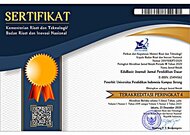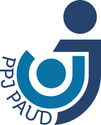Development of a Financial Literacy Book, "Good and Bad Character Augmented Reality," for Early Childhood
Abstract
Financial literacy education needs to be instilled from an early age through attractive media so that it is internalized and to form managing finances habits in the future. Augmented Reality (AR) technology is an alternative since it is in the 3D form to visualize abstract concepts into concrete ones. This study aims to develop a financial literacy book with augmented reality technology, "Good and Bad Character AR." This book instills financial knowledge and experience for children in forming good character and habits. The method used in this study was Design & Development (D&D), with an analysis model of design, development, implementation, and evaluation (ADDIE). Participants were material and media experts and users (teachers and children aged 5-6 years) at the UPI Campus Labschool Kindergarten in Serang. Validation was carried out by media experts, material experts, two teachers, and five children. The analysis results demonstrated that the financial literacy book "Good and Bad Character AR" was feasible for educators to use in increasing early childhood financial literacy based on the assessment of material experts of 85.33% and media experts of 87%, with a very good category. Meanwhile, the user response came from two teachers respectively at 98.33 and 90%, considered very good in terms of the attractiveness of the content, ease of use, and the children's enthusiasm during learning. In addition, of the five children, 92% were obtained, indicating a very good response. It indicated that AR technology is feasible and potentially used in early childhood learning.
Keywords
Full Text:
PDFReferences
Ariyani, D. (2018). Pendidikan literasi keuangan pada anak usia dini di TK Khalifah Purwokerto. Yinyang: Jurnal Studi Islam Gender dan Anak, 13(2), 175–190.
Cahyaningtyas, A. S. (2020). Pembelajaran menggunakan augment reality untuk anak usia dini di Indonesia. Jurnal Teknologi Pendidikan, 5(2), 20–37.
Devincenzi, S., Kwecko, V., De Toledo, F. P., Mota, F. P., Casarin, J. & Botelho, S. S. C. (2017) Persuasive technology: Application in education. 2017 IEEE Frontiers in Education Conference (FIE), 1–7.
Fitriasari, N. S., Suzanti, L., Widjayatri, R. R. D., Putri, K. A., Fakhrurrazi, M., Zamil, A. C., & Rahayu, G. (2020). Interactive animation media of sea biota design for young learners. Journal of Physics: Conference Series, 1811, e012098.
Firdaus, F., Adnan, K., & Fajrin, A. (2023). Efektivitas model pembelajaran kooperatif berbasis Group Investigation terhadap peningkatan hasil belajar IPS siswa kelas V. Jurnal Pendidikan & Pembelajaran Sekolah Dasar, 3(1), 73–82.
Hasbi, M. (2021). Memulai gerakan literasi dari rumah. Majalah PAUDPEDIA, 5(2), 6–8.
Kurniawan, A. P., Sartono, N. N., Zikra, F. A., & Ulwan, A. I. (2019). Multimedia augmented reality technology in daily basic knowledge learning media for early childhood and kindergarten. International Journal of Applied Information Technology (IJAIT), 3(1), 18–23.
Nabila A., Devi A., & Indriya I. (2021). Konseptualisasi peran strategis pada pendidikan literasi keuangan syariah anak melalui pendekatan systematic review di TK RA Al-Mu’min Gunung Putri. Al-Kharaj: Jurnal Ekonomi, Keuangan & Bisnis Syariah, 4(1), 79–95.
Novieningtyas, A. (2018). Pentingnya edukasi literasi keuangan sejak dini. Manners: Management and Entrepreneurship Journal, 1(2), 133–137.
Oktaviani, R. F., Meidiyustiani, R., Qodariah, Q., & Iswati, H. (2022). Edukasi menumbuhkan literasi finansial pada anak usia dini di masa pandemi covid-19. Abdi MOESTOPO: Jurnal Pengabdian pada Masyarakat, 5(2), 133–140.
Priska, V. H. (2020). Pentingnya menanamkan karakter sejak dini. EduPsyCouns: Journal of Education, Psychology and Counseling, 2(1), 193–201.
Reynolds, A. J., & Candee, A. J. (2019). Dimensionality and predictive validity of classroom learning activities checklist in prekindergarten. Educational Assessment, Evaluation, and Accountability, 31, 381–407.
Salas-Velasco, M., Moreno-Herrero, D., & Sánchez-Campillo, J. (2021). Teaching financial education in schools and students' financial literacy: A cross-country analysis with PISA data. International Journal of Finance and Economics, 26(3), 4077–4103.
Saputra, J., & Susanti, D. (2021). A study of several financial literacy teaching methods for children. International Journal of Ethno-Sciences and Education Research, 1(2), 7–10.
Sari, R. C., Aisyah, M. N., Ilyana, S., & Hermawan, H. D. (2022). Developing a financial literacy storybook for early childhood in an augmented reality context. Contemporary Educational Technology, 14(2), ep363.
Sari, R. C., Fatimah, P. L. R., Ilyana, S., & Hermawan, H. D. (2022b). Augmented reality (AR)-based sharia financial literacy system (AR-SFLS): A new approach to virtual sharia financial socialization for young learners. International Journal of Islamic and Middle Eastern Finance and Management, 15(1), 48–65.
DOI: https://doi.org/10.17509/ebj.v5i1.51996
Refbacks
- There are currently no refbacks.
Copyright (c) 2023 Universitas Pendidikan Indonesia
This work is licensed under a Creative Commons Attribution 4.0 International License.
This journal is indexed by




.png)




.png)
1.png)


1.png)

.png)